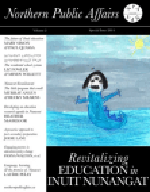Findings
What we are findingFindings show that connection to culture is important to youth and that finding opportunities to engage in cultural activities is of key concern for them. Across sites, youth believe that more human resources, service providers, and financial resources need to be made available to support youth engagement in cultural and community activities. Importantly, these resources and opportunities need to be structured in ways that make sense to youth. As such, youth believe their voices need to be heard and even more importantly, centralized, in order to make meaningful change for themselves and their peers today. What is exciting about the project is that while two of the three sites highlight the need for these connections, and provide insights into what structures may facilitate them, findings from the third community show the impact of these connections once they are established.
Youth of Spaces & Places, Eskasoni, Liebenberg, L., Reich, J., Hutt-MacLeod, D., Denny, J-F., Gould, M. R. (in press). Two-eyed seeing for youth wellness: Promoting positive outcomes with interwoven resilience resources. Transcultural Psychiatry
Wood, M., Liebenberg, L., Ikeda, J., Vincent, A., & Youth participants of Spaces & Places (2020). The role of educational spaces in supporting Inuit youth resilience. Child Care in Practice. DOI:10.1080/13575279.2020.1765143
Wall, D., Liebenberg, L., Ikeda, J., Davis-Ward, D., & Youth of Spaces & Places, Port Hope Simpson (2021). Understanding community, culture and recreation as resilience resources for Indigenous youth. In L. Moran, K. Reilly, & B. Brady (Eds.), Narrating Childhoods across Contexts: Knowledge, Environment, and Relationships (pp. 163-187). Basingstoke, UK: Palgrave.






